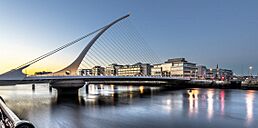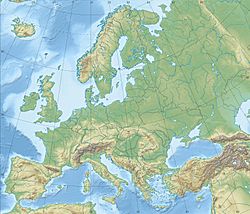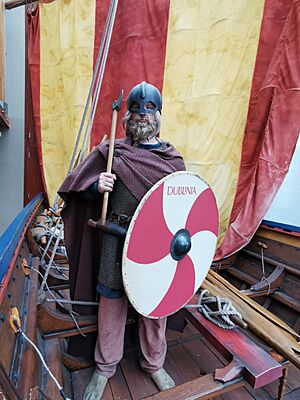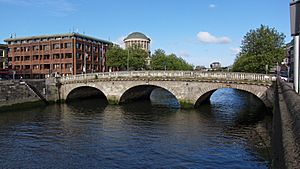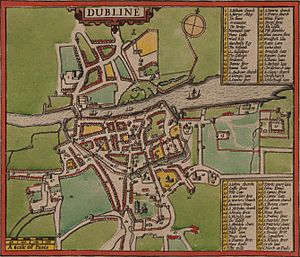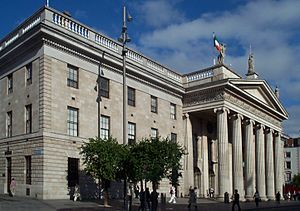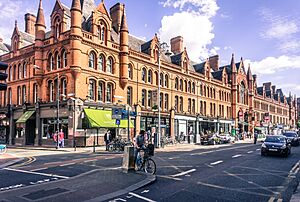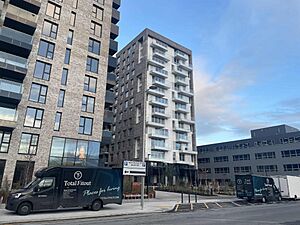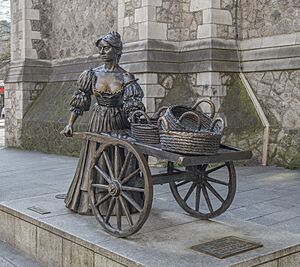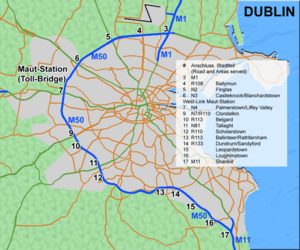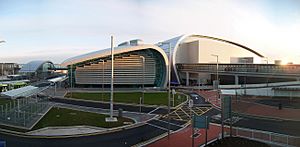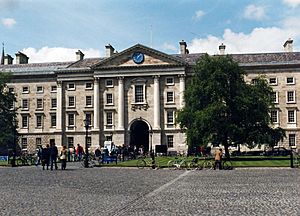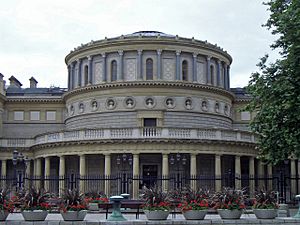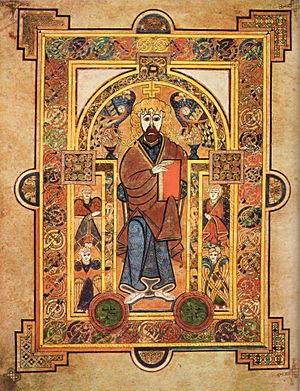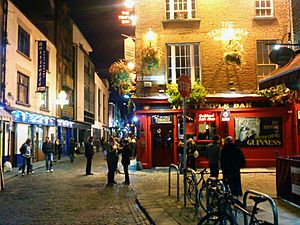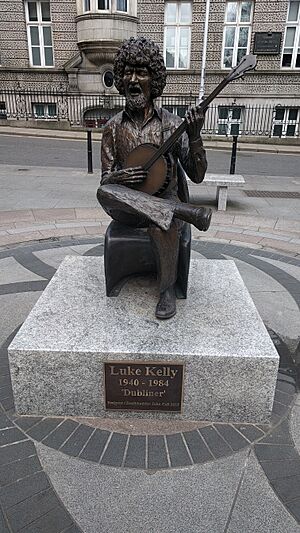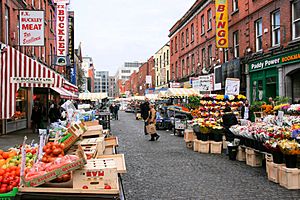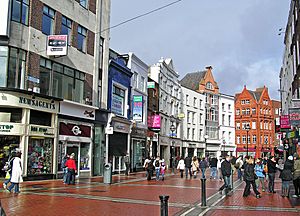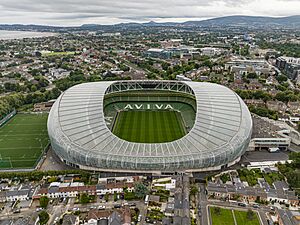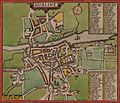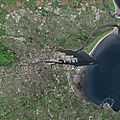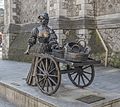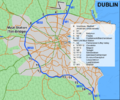Dublin facts for kids
Quick facts for kids
Dublin
Irish: Baile Átha Cliath
|
|||
|---|---|---|---|
|
Samuel Beckett Bridge
O'Connell Bridge
|
|||
|
|||
| Nickname(s):
The Fair City
|
|||
| Motto(s):
Obedientia Civium Urbis Felicitas
"The obedience of the citizens produces a happy city" Alternatively translated as "An obedient citizenry produces a happy city" |
|||
| Country | Ireland | ||
| Province | Leinster | ||
| Region | Eastern and Midland | ||
| County | Dublin | ||
| Founded | Unknown | ||
| Area | |||
| • Capital city | 117.8 km2 (45.5 sq mi) | ||
| • Urban | 345 km2 (133 sq mi) | ||
| Population
(2022)
|
|||
| • Capital city | 592,713 | ||
| • Density | 5,032/km2 (13,030/sq mi) | ||
| • Urban
(2024)
|
1,534,900 | ||
| • Urban density | 4,449/km2 (11,520/sq mi) | ||
| • Ethnicity (2022 census) |
Ethnic groups
|
||
| Demonyms | Dubliner, Dub | ||
| Time zone | UTC+00:00 (GMT) | ||
| • Summer (DST) | UTC+01:00 (IST) | ||
| Eircode |
D01 to D18, D20, D22, D24 & D6W
|
||
| Area code(s) | 01 (+3531) | ||
| ISO 3166 code | IE-D | ||
| GDP | €157.2 billion (city) €222.1 billion (greater) | ||
| GDP per capita | €108,500 (city) €106,600 (greater) | ||
Dublin (pronounced DUB-lin) is the capital city of Ireland. It sits on a bay where the River Liffey meets the sea. The city is in the province of Leinster, with the Dublin Mountains to its south. In 2022, the city area had about 592,713 people. Including its suburbs, the population was around 1.26 million, making it the largest city on the island of Ireland.
People have lived in this area since before the 7th century. The Vikings later settled here. By the 12th century, Dublin became Ireland's main settlement. The city grew very fast from the 1600s. After Ireland became independent in 1922, Dublin became its capital. Today, Dublin is known as a "global city," ranking among the top cities worldwide.
Contents
- Understanding Dublin's Name
- Dublin's Past: A Journey Through Time
- Dublin's Landscape and Climate
- Exploring Dublin's Cityscape
- Dublin's Economy
- Getting Around Dublin
- Learning in Dublin: Education Hub
- People of Dublin: Demographics
- Dublin's Culture and Entertainment
- Sports in Dublin
- Dublin's Cuisine
- International Connections
- Images for kids
Understanding Dublin's Name
The name Dublin comes from an old Irish word, Duiblinn. This word means "Blackpool." It refers to a dark tidal pool where the River Poddle joined the River Liffey. This spot was near where Dublin Castle now stands.
The Irish name for the city is Baile Átha Cliath. This means "town of the hurdled ford." A "ford" is a shallow place in a river where you can cross. This name refers to a crossing point on the River Liffey.
Dublin's Past: A Journey Through Time
People have lived around Dublin Bay for a very long time. Fish traps found during building work show humans were here 6,000 years ago. The Greek-Roman mapmaker Ptolemy mentioned a settlement near Dublin around 140 AD. He called it Eblana polis.
Dublin celebrated its 1,000th birthday in 1988. This means the Irish government recognized 988 as the year the city was first settled.
Historians now think a Christian settlement called Duibhlinn existed before the Vikings arrived. The Vikings set up their own settlement, Dyflin, around 841. There was also a Gaelic settlement, Áth Cliath, further up the river. These two settlements eventually grew together to form modern Dublin.
Dublin in the Middle Ages
In 841, the Vikings built a strong base in Dublin. It became an important trading center. Even with attacks from the native Irish, the Vikings mostly controlled it until 1169. That's when the Normans invaded Ireland from Wales.
The King of Leinster, Diarmait Mac Murchada, asked for help from Strongbow to take Dublin. After Mac Murchada died, Strongbow took control. Then, Henry II of England came with a larger army in 1171 and became the Lord of Ireland.
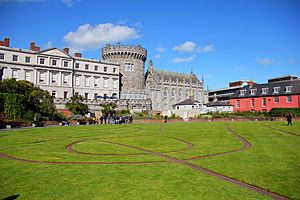
Dublin Castle was built in 1204 by King John of England. It was a major defense point for the city. By the late 1200s, Dublin had grown to about 8,000 people. It was a busy trading town. However, it was a small walled town and faced threats from local clans. In 1348, the Black Death plague hit Dublin, killing thousands.
Dublin was the main city in "the Pale." This was a small area along the east coast controlled by the English Crown. In the 1500s, the English took more control of Ireland. Dublin became the center of English rule. Queen Elizabeth I wanted Dublin to be a Protestant city. She founded Trinity College Dublin in 1592 as a Protestant university.
By 1640, Dublin had 21,000 people. But a plague from 1649 to 1651 killed almost half of them. The city soon recovered, thanks to the wool and linen trade. By 1700, its population was over 50,000.
Dublin's Modern History
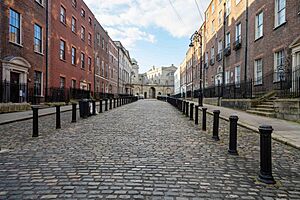
In the 1700s, Dublin became the second-largest city in the British Empire. It was the fifth-largest city in Europe, with over 130,000 people. Many new buildings and areas were built during this time, like Merrion Square and Parliament House. The Guinness brewery started in 1759. It grew to be the world's largest brewery.
Dublin faced challenges in the 1800s. The government moved to London in 1800. The city did not play a big part in the Industrial Revolution. However, it remained an important center for administration and transport.
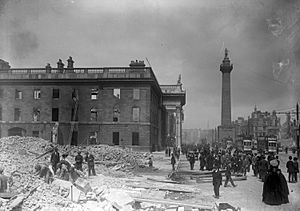
Major events like the Easter Rising of 1916 and the Irish War of Independence caused a lot of damage in central Dublin. After Ireland gained independence in 1922, Dublin became the capital of the Irish Free State. The new parliament, the Oireachtas, was set up in Leinster House.
Dublin also experienced violence during the conflict in Northern Ireland. A group called the Ulster Volunteer Force bombed the city in 1974. This attack, known as the Dublin and Monaghan bombings, killed 34 people.
In the mid-1900s, many old Georgian buildings were pulled down. This was to build new offices. This led to fewer people living in the city center. But since 1997, Dublin has changed a lot. During the "Celtic Tiger" period, Ireland's economy grew fast. Dublin saw many new homes, transport links, and businesses. After a tough economic time, Dublin has recovered. It now has almost full employment.
Dublin's Landscape and Climate
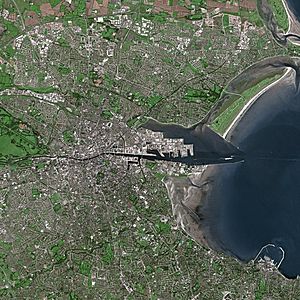
Dublin is located where the River Liffey meets the sea. Its urban area covers about 345 square kilometers. The Dublin Mountains are to the south. Flat farmland stretches to the north and west.
Rivers and Canals
The River Liffey splits the city into two parts: the Northside and the Southside. The city began where the smaller River Poddle joined the Liffey. Other rivers like the Tolka and Dodder also flow into the sea.
Two canals, the Grand Canal (south) and the Royal Canal (north), go around the inner city. Both connect to the River Shannon.
Weather in Dublin
Dublin has a mild climate, like much of northwest Europe. Summers are warm, and winters are cool. Extreme temperatures are rare. The coldest month is February, and the warmest is July.
Dublin is the driest place in Ireland. It gets about half the rainfall of the west coast. Snow showers can happen between November and March. Hail is more common than snow. Strong winds from the Atlantic are most common in autumn.
In the 1900s, smog and air pollution were a problem. A ban on certain fuels in 1990 helped reduce pollution. This has led to fewer deaths from heart and breathing problems.
Exploring Dublin's Cityscape
City Areas
The historic center of Dublin is surrounded by the Royal Canal and Grand Canal. O'Connell Street is the main street in the inner city. Many bus routes and the Luas tram stop there. Popular shopping streets are Henry Street (Northside) and Grafton Street (Southside).
Inner Dublin is sometimes divided into different areas. These include the Medieval Quarter (around Dublin Castle), the Georgian Quarter (around St Stephen's Green), the Docklands Quarter (near the Dublin Docklands), and the Cultural Quarter (around Temple Bar).
Suburbs of Dublin
Dublin has many suburbs. On the Northside, you'll find places like Blanchardstown and Howth. On the Southside, there are suburbs like Tallaght and Dún Laoghaire. In recent years, many new apartments have been built in these suburbs.
There used to be a traditional divide between the Northside and Southside, with the Southside seen as wealthier. There are also differences between the coastal suburbs and newer areas to the west.
Famous Landmarks
Dublin has many old landmarks and monuments. One of the oldest is Dublin Castle. It was built in 1204 as a defense for the city. It was the center of British rule in Ireland until 1922.
One of Dublin's most famous landmarks is the Spire of Dublin. It's a 121.2-meter tall stainless steel spire. It was finished in 2003 and stands on O'Connell Street. It replaced an older monument and represents Dublin in the 21st century.
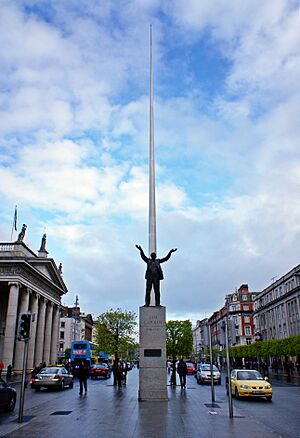
The Old Library at Trinity College Dublin is very popular. It holds the Book of Kells, an ancient illustrated manuscript. The Ha'penny Bridge, an iron footbridge over the River Liffey, is also a famous sight.
Other landmarks include Christ Church Cathedral, St Patrick's Cathedral, the Mansion House, and the Molly Malone statue. The Poolbeg Towers are also well-known features of the city.
Parks and Green Spaces
Dublin has over 300 parks and green spaces. The city council manages more than 1,500 hectares of parks. Famous public parks include Phoenix Park, St Stephen's Green, and Saint Anne's Park.
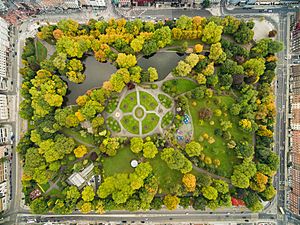
Phoenix Park is about 3 kilometers west of the city center. It's one of Europe's largest walled city parks, covering 707 hectares. It has grasslands, tree-lined roads, and a herd of wild fallow deer. The home of the President of Ireland is in the park. Dublin Zoo is also located there.
St Stephen's Green is next to Grafton Street, a main shopping street. Saint Anne's Park is the second-largest park in Dublin. It was once part of a large estate owned by the Guinness family.
Dublin's Economy
Dublin is the economic heart of Ireland. It led the country's economic growth during the "Celtic Tiger" period. In 2009, Dublin was ranked as one of the richest cities in the world.
Many old industries like food processing and textile making have shrunk. But Guinness beer has been brewed at the St. James's Gate Brewery since 1759. In the 1990s, many global technology and pharmaceutical companies came to Dublin. Companies like Microsoft, Google, Amazon, and Facebook have European offices here. This has made Dublin known as the "Tech Capital of Europe."
Financial services are also very important. Dublin's International Financial Services Centre (IFSC) was set up in 1987. Many international banks and insurance companies are based there. Dublin is now a key city for financial services in Europe.
Getting Around Dublin
Roads and Buses
Ireland's road network mostly focuses on Dublin. The M50 motorway goes around the city. It connects major national roads to the rest of the country. The Dublin Port Tunnel opened in 2006. It helps heavy vehicles get to Dublin Port from the M1 motorway.
Dublin has a large bus network with nearly 200 routes. Most are run by Dublin Bus. A "Real Time Passenger Information" system shows when buses will arrive. The TFI Leap Card is a smart card you can use for all public transport in Dublin.
Cycling in the City
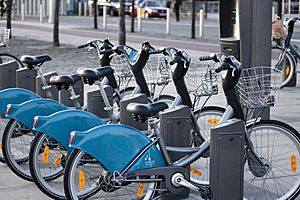
More and more people are cycling in Dublin. In 2011, about 5.9% of commuters cycled. Dublin City Council has built over 200 kilometers of cycle lanes.
Dublinbikes is a bike rental system that started in 2009. You can rent bikes from many stations across the city center. It's a popular way to get around.
Trains and Trams

Dublin has two main train stations: Heuston and Connolly. The Dublin Suburban Rail network serves the Greater Dublin Area. The Dublin Area Rapid Transit (DART) line runs along the coast.
Dublin used to have many trams, but they were mostly removed by 1949. A new light rail system, called the Luas, opened in 2004. It carries over 34 million passengers each year. It has two lines: the Red Line and the Green Line. They connect the city center with different suburbs. There are also plans for a new metro service called Metrolink. It would run from the northside to the city center, including Dublin Airport.
Air Travel
Dublin Airport is north of the city. It is owned by DAA. It is the headquarters for Aer Lingus and CityJet. Ryanair is also based nearby. The airport has flights across Europe, to the United States, Canada, and the Middle East. It is the busiest airport in Ireland. In 2019, almost 33 million passengers used Dublin Airport.
Learning in Dublin: Education Hub
Dublin is the biggest center for education in Ireland. It has four universities and many other higher education places. In 2012, it was the European Capital of Science.
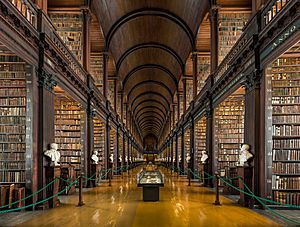
The University of Dublin is the oldest university in Ireland. It dates back to the 1500s. Its main college, Trinity College Dublin (TCD), was founded in 1592. It is in the city center and has over 18,000 students.
University College Dublin (UCD) is the largest university in Ireland. It has over 30,000 students. Its main campus is in Belfield, about 5 kilometers from the city center.
The Dublin Institute of Technology (DIT) has joined with two other colleges to form Technological University Dublin. This is Ireland's second-largest university. It offers many courses in engineering, science, business, and arts.
Dublin City University (DCU) offers courses in business, engineering, science, and languages. It has about 16,000 students. Its main campus is about 7 kilometers from the city center.
Other important colleges include the Royal College of Surgeons in Ireland (RCSI) for medicine, and the National College of Art and Design (NCAD) for art and design. Dublin is also home to the Royal Irish Academy, Ireland's highest academic honor.
People of Dublin: Demographics
The City of Dublin is managed by Dublin City Council. The wider County Dublin includes the city and three other administrative counties. The Greater Dublin Area includes County Dublin and nearby counties.
In 2022, the population of Dublin city was 592,713. The population of Dublin city and its suburbs was 1,263,219. Most people (62.9%) were born in Dublin. About 26.6% were born outside Ireland.
Since the late 1990s, many people have moved to Dublin. Most come from the European Union, especially the United Kingdom, Poland, and Lithuania. People also come from places like Pakistan, Brazil, and China. Dublin has more new arrivals than any other part of Ireland.
Most Dubliners speak English. However, many thousands of people also speak Irish every day. There are many Irish-language schools in Dublin. Two Irish radio stations, Raidió Na Life and RTÉ Raidió na Gaeltachta, have studios in the city.
Dublin's Culture and Entertainment
Dublin has a rich history of literature. Many famous writers come from Dublin, including Nobel laureates William Butler Yeats, George Bernard Shaw, and Samuel Beckett. James Joyce set many of his famous works, like Ulysses, in Dublin. In 2010, Dublin was named a UNESCO City of Literature.
Handel's famous music piece, Messiah, was first performed in Dublin in 1742.
There are several theaters in the city center. Many well-known actors have come from Dublin. The most famous theaters include the Gaiety, Abbey, Olympia, and Gate. The Grand Canal Theatre is a newer theater that opened in 2010.
Dublin is also a center for Irish art. The Book of Kells, a world-famous manuscript, is on display at Trinity College Dublin. The Chester Beatty Library has a large collection of old manuscripts and art from around the world.
Public art galleries are free to visit. These include the Irish Museum of Modern Art and the National Gallery. Three branches of the National Museum of Ireland are also in Dublin.
Nightlife and Music
Dublin has a lively nightlife. It's known as one of Europe's most youthful cities. There are many pubs and nightclubs, especially around St. Stephen's Green and Grafton Street.
The most famous area for nightlife is Temple Bar. It was developed as Dublin's cultural quarter. It still has small art studios and music venues.
Live music is played everywhere in Dublin. The city has produced many famous musicians and bands. These include the Dubliners, Thin Lizzy, U2, and the Script. Large concerts are held at the 3Arena.
Shopping in Dublin
Dublin city center is a popular place to shop. The main shopping areas are around Grafton Street and Henry Street. You'll find large department stores like Arnotts and Brown Thomas.
Moore Street is one of the city's oldest trading areas. There are also many modern shopping centers in Dublin's suburbs. These include Dundrum Town Centre and Blanchardstown Centre.
Media and Communications
Dublin is the center for media and communications in Ireland. Many newspapers, radio stations, and TV stations are based here. RTÉ is Ireland's national broadcaster. Its soap opera, Fair City, is set in a fictional Dublin suburb.
The headquarters of An Post (Ireland's postal service) and major phone companies are also in Dublin. National newspapers like The Irish Times are based here. Dublin also has many local and national radio stations.
Sports in Dublin
Gaelic Games
Croke Park is the largest sports stadium in Ireland. It is the home of the Gaelic Athletic Association (GAA). It can hold 82,300 people. It hosts the biggest Gaelic football and hurling games. It also hosts concerts and other events. The Dublin GAA team plays most of its home games at Parnell Park.
Rugby and Football
The Aviva Stadium is a modern 50,000-seat stadium. It opened in 2010. It is the home ground for the Irish Rugby Union Team and the Republic of Ireland national football team. It has hosted major rugby finals.
Dublin has five League of Ireland football clubs: Bohemian, Shamrock Rovers, Shelbourne, St Patrick's Athletic, and University College Dublin.
Other Sports
Dublin hosts the Dublin Marathon every October. The Dublin Women's Mini Marathon is held in June. It is said to be the largest all-female event of its kind in the world.
The National Stadium in Dublin is the national boxing arena. The National Basketball Arena is in Tallaght. The National Aquatic Centre in Blanchardstown is Ireland's largest indoor water facility.
Dublin's Cuisine
Dublin has many great restaurants. As of 2022, several Dublin restaurants have been awarded Michelin stars. These include Restaurant Patrick Guilbaud and Chapter One.
Coffee houses and cafes have become very popular in Dublin. Irish coffee chains like Insomnia now compete with international brands.
Immigrant groups have opened restaurants with food from around the world. You can find Chinese, Japanese, and Italian restaurants. A popular modern Irish-Chinese dish is the Spice bag. It was voted 'Ireland's Favourite Takeaway Dish' in 2020.
International Connections
Dublin is connected to cities around the world. It has "twin city" agreements with five places:
| City | Nation | Since |
|---|---|---|
| San Jose | United States | 1986 |
| Liverpool | United Kingdom | 1997 |
| Barcelona | Spain | 1998 |
| Beijing | China | 2011 |
| Ramallah | Palestine | 2023 |
The city also has "friendship" agreements with other cities like Moscow and St Petersburg in Russia.
Images for kids
Error: no page names specified (help). In Spanish: Dublín para niños
In Spanish: Dublín para niños


